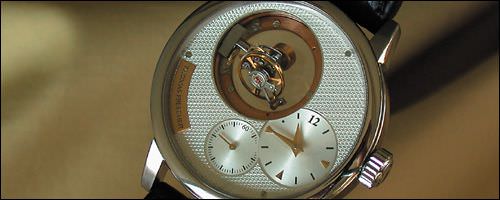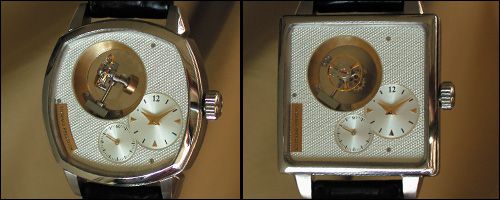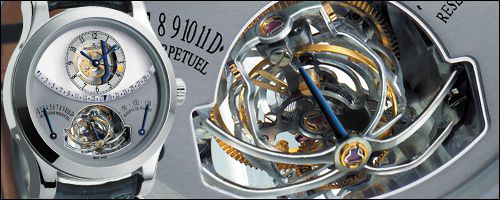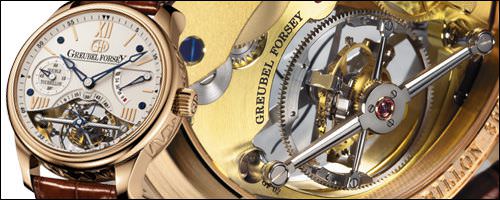During the 20th century, there have been a few oscillating and whirling precursors of today’s inventers, who have modified the rotational speed of the tourbillon or have sent it flying into space. Albert Potter, an American watchmaker active during the latter half the 19th century, made a tourbillon with a totally unheard of rotational speed, that of 1 revolution in 12 seconds. This same Mr. Potter was one of the first, around 1860, to construct a tourbillon with an inclined balance for a carriage clock
The German watchmaker Walter Prendel drew inspiration from the master horologer Alfred Helwig and tried again in 1928 to place the tourbillon in space, this time in a pocket watch. The balance spring and rotor was inclined 30 degrees from the horizontal and made one rotation in six minutes.
Marcel Vuilleumier, in 1947 at the Ecole professionnelle in the Vallée de Joux, incorporated two balance springs in the same tourbillon cage. In 1980, English watchmaker Anthony Randall, who learned his trade at the Technicum in La Chaux-de-Fonds during the 1960s, patented the first tourbillon with two perpendicular axes.
More than twenty years later, Richard Danners developed a double-axis tourbillon in a large 55-mm pocket watch for Gübelin. (The smallest tourbillon movement measured 19.7 mm and was built in Le Locle in 1947 by a certain Fritz Robert-Charrue.)
The tourbillon was invented in 1795 and patented in 1801 by Abraham-Louis Breguet specifically for pocket watches that were carried in a vertical position in a vest pocket. The precision of a watch is based on the averaging of the different running times in the vertical positions. The initial goal of Breguet’s device was to eliminate the differences of position by making the balance rotate once per minute. In this way, the various differences in all the positions should result in a constant average working time.
It is widely recognized today that this invention is not really useful for wristwatches since the simple fact of wearing the watch averages out the positions naturally. A complication that has become superfluous, the tourbillon nevertheless still satisfies an insatiable visual pleasure by its lively technical beauty.
For more than two centuries, the greatest names in watchmaking have dabbled in tourbillons. More recently, during the 1980s, the renewed interest in complicated mechanical watches placed this example of watchmaking’s technical prowess once again in the limelight. The exceptional dexterity and skill necessary to make them work was again put to the test.

TRIPLE-AXIS TOURBILLON by Thomas Prescher

DOUBLE & SINGLE-AXIS TOURBILLONS by Thomas Prescher
Thomas Prescher or the third dimension
This young watchmaking genius, born in Germany, learned his craft at Audemars Piguet and at Gübelin in Lucerne. Like Greubel and Forsey (see ‘An angle for beauty’ in this article), he is a member of the Horological Academy of Independent Creators (Académie Horlogère des Créateurs Indépendants, AHCI) created in 1984 by Vincent Calabrese and Svend Andersen.
The first person to have patented the doub-le-axis tourbillon was Anthony Randall in 1978. After twenty years, this patent fell into the public domain. Based on the work of Randall, Richard Good patented his triple-axis tourbillon. The first double-axis tourbillons made by Randall, Good, and later by Richard Habring, were for carriage clocks. Since they were on a fixed movement, they did not have to endure sudden changes in position as did classic watches.
Franck Muller was the first to adapt these doub-le-axis systems to a wristwatch, but Thomas Prescher is the first to have conceived a double axes flying tourbillon with a constant force device on a wristwatch!
We know that, in earlier times, the tourbillon was adapted for a pocket watch (carried vertically in the vest pocket) in order to compensate for the negative effects of the disequilibrium of the balance. In a wristwatch, the balance is still subject to the effects of gravity in a vertical position, a decrease in amplitude and a change in running between a horizontal and vertical position, due to friction of the pivots.
Breguet, in his patent description, before he spoke of compensating for the effects of gravity, evoked the poising of friction along the entire circumference of the pivots, and their homogenous lubrication.
Therefore, in theory, the ideal solution for compensating for differences in the running of a wristwatch between horizontal and vertical positions would be the double-axis tourbillon. And to maintain constant amplitude, Thomas Prescher had the ingenious idea of adding a constant force device, a ‘remontoir d’égalité’, that would allow the regular winding of a small subsdiary spring in order to ensure constant force. This remontoir prevents the escapement from being subjected to the variations in driving force from the barrel spring and thus maintains constant amplitude of the balance.
The two barrels of his double axis movement provide a working reserve of 42 hours, and the equality remontoir provides constant amplitude during 40 hours. In a classic movement, the loss of amplitude comes much earlier. However, the constant minimum amplitude is closely linked to the correct running of the balance.
Prescher’s remontoir also corrects for isochronal errors. A balance is isochronal when its oscillation time remains identical, regardless of the variations in amplitude. Theoretically, good regulation means obtaining perfect isochronism in the oscillations. There have been many inventions to remedy the ‘perturbing’ factors related to the escapement, the errors in balance equilibrium, centrifugal force and even magnetic fields.
After obtaining equilibrium in his double-axis tourbillon, Thomas Prescher also succeeded in bringing together a number of other excellent ingredients in order to achieve optimal precis-ion. The two cages each make one revolution in one minute. In theory, with the two identical times of rotation, there is less mingling of the positions. The balance would most likely find itself often in an unfavourable position, but in practice, the difference is insignificant.
We must also salute the magnificent technical prowess that is found in Thomas Prescher’s triple-axis tourbillon. The third axis makes a revolution in one hour and can rotate simultaneously with the hand position when setting the hour. Has Prescher succeeded, with his triple-axis tourbillon, in becoming ‘more royalist than the king’? Useful or not, the performance of this extraordinary device satisfies our insatiable technical fascination. He said it himself: “Ultimate precision is not the final goal. The principal idea is to create excitement.â€

Gyrotourbillon 1 by Jaeger-LeCoultre
The revolutionary sphere
Once more, Jaeger-LeCoultre has offered a surprise, and carried us up into the rarefied sphere of watchmaking art. This time the remarkable creation is the Gyrotourbillon I, developed technically by Eric Coudray with the collaboration of Magali Métrailler for design.
Coudray and Métrailler clearly demonstrate that the technical is not inseparable from the design in this remarkable double-axis tourbillon. Were these creators inspired by the armillary spheres of ancient astronomers? (A globe formed of rings and circles, representing the sky and the stars?)
Whatever their inspiration, let’s return to the ingenious inventiveness of Eric Coudray as he juggled his new forms while using materials rarely, if ever, seen in watchmaking. The balance oscillates thanks to the driving force of the movement distributed to the wheel from the barrel. This force has to be transmitted in the most optimal manner, with the least loss of energy. To reduce to a minimum friction and rubbing, the two barrel springs are enclosed between a base and cover made of sapphire crystal. The driving force is transmitted in a constant manner for eight days, thus affording constant amplitude to the balance, giving better regulation. It is worth mentioning that the sapphire crystal had been already used in a similar manner but in clocks.
The tourbillon cage owes its revolutions to the impulsion of the escapement. Like the balance spring, the cage must be in perfect equilibrium, whether it is simple, double-axis or triple-axis. It must have the least inertia possible, that is, it must be the lightest it can be for the same energy. The centre of gravity must also be at the centre of the sphere. To achieve this, two materials were used, titanium and aluminium. Aluminium is much lighter than titanium, with densities of 2.6 and 4.5 kg/m3, compared to gold at 19.3.
The internal cage that supports the balance and the escapement is made of titanium, while the external cage is of aluminium. Titanium is used in order to ensure the centre of gravity at the physical centre of the sphere. These two cages are positioned at 90°. Because of gravity, the screws have been carefully positioned. The balance is made of 14 carat gold in order to have optimal moment of inertia, thus giving better performance. According to the energy available in the movement, the ideal balance has a large moment of inertia for a weak mass. To improve the inertia even more, holes have been made in the arms of the balance. The Breguet spiral, commonly used today, allows for a concentric development, thus giving better regulation. The 21,600 vibrations per hour of the balance spring had already been used in movements constructed by Breguet as well as in his first tourbillon regulator.
According to Breguet, the choice of 21,600 vibrations per hour permits improvement in regulation since the balance is less affected by the watch’s movements when it is worn. If, for example, the watch oscillates in the sense of the balance’s movement, it slows down, and vice-versa. If the watch oscillates at the same speed of the balance, it will temporarily stop. The more quickly the balance oscillates, the less chance there is that the watch will move at the same speed, and thus the regulation will be more stable.
With a power reserve of eight days, Eric Coudray preferred to choose 21,600 vibrations per hour. It is known that when the vibrations are faster, there is more friction and rubbing, thus more problems of lubrication. The rotation speeds of the two cages were carefully selected. One makes a revolution in one minute, while the second completes two and a half turns per minute. These two speeds were chosen in order to reconcile optimal chronometry (avoiding prolonged time duration of the balance spring in the most unfavourable positions) with visual pleasure. Combining these two speeds, the complete cycle of the cage takes two minutes.
There is no question that Jaeger-LeCoultre has seduced us with this new creation. Already a holder of many patents, the Gyrotourbillon I allies technical expertise with design, bringing together the best of both worlds. Is there a Gyrotourbillon 2 waiting in the wings? To be continued…

DOUBLE TOURBILLON 30° by Greubel-Forsey
An angle for beauty
If the new crop of tourbillons was so successful this year, it was partly because of the efforts of Robert Greubel and Stephen Forsey. Both men have worked at Renaud et Papi, a famous ‘laboratory’ for ideas and research, that belongs to Audemars Piguet. The 30° angle of the second axis of the tourbillon is the first for a wristwatch. This particular angle was chosen so that the balance would never be in a horizontal position, say its inventors. It was also selected for its aesthetic appearance so that the case maintains a reasonable thickness. This 30º angle also allowed the watchmakers to use a larger balance and thus permit better regulation with a larger moment of inertia.
The first cage makes one revolution in four minutes. The second mobile cage, which supports the escapement and balance spring, makes a revolution in one minute. These two rotations, in one and in four minutes, permit a homogeneous averaging of the balance positions, and reduce the probability that the balance will be in an unfavourable position. This would not be the case, for example, of having both rotations at one minute where the cycle would be shorter. Because the second cage is inclined by 30°, the movement of the balance turns in the form of a cone. In a horizontal position, the balance will thus never be flat. It will therefore never be subjected to the violent working and amplitude variations between the flat and vertical positions. However, once on the wrist, the balance will naturally be subjected to changes in position. The size of the balance and its system of variable inertia, will then come into play to compensate for these changes.
The movement is equipped with two barrels, giving a power reserve of three days. One of them is equipped with a slip spring, a device generally used for automatic watches. This slip spring prevents the over-winding of the watch, a simple security measure for the mechanism, but also for the balance, which without this device, would be subject to major increases in amplitude.
It should also be noted the extreme level of attention to details in this model. From the polished screw to the tourbillon cage, as well as the various wheels, this watch offers a wonderful example of the fine art of watchmaking. There is nothing more that could satisfy and delight the most demanding collectors.
Towards new conquests?
It has been widely recognized that a tourbillon, in principle, is not any more precise than the classic, well-adjusted balance spring. Reinhard Meis, in his reference book on the tourbillon, has discussed this fact, based on a series of tests on the tourbillon. Yet, this device still commands great respect in watchmaking, and allows us to honour the skill and ingenuity that this device demands of the most experienced and talented master watchmakers.
These brilliant creators, by adding a second and third dimension to the tourbillon, have created the most extraordinary building block in the edifice of time that has been so highly coveted during the last two hundred years. Beyond the technical debate, why should we tire of such wonderful works of art that continue to evoke excitement and emotion? Why should we deprive ourselves of such beauty?
A masterpiece of art should be seen, and when it is placed in a movement, what could be better than to appease the thirst of the most demanding collectors by combining it with the nearly limitless creativity and inventiveness of certain watchmakers.
Up to now, a myriad of technical inventions for watches have seen the light of day in the continuing search for ultimate precision. Does the improvement of an invention then become a new invention in itself?
The second and third dimensions are already conquered. So what’s left to invent? The conquest of the seas and the mastery of longitude have led us to precision and chronom-etry. The conquest of space has brought us new materials that are improving precision, strength and efficiency. Will today’s inventiveness reside uniquely in the research of new materials or in the alloys that already exist? Surely not. The challenge is on – new contenders get ready!
Bibliography:
![]() Théorie d'horlogerie (Horological Theory)
Théorie d'horlogerie (Horological Theory)
by Charles-André Raymondin
![]() The Art of Breguet by George Daniels
The Art of Breguet by George Daniels
![]() Chronométrophilia magazine on the tourbillon
Chronométrophilia magazine on the tourbillon
![]() Omega Saga, Synoptical Chronology of horology
Omega Saga, Synoptical Chronology of horology
![]() Illustrated Professional Dictionary of Horology
Illustrated Professional Dictionary of Horology
by G-A Berner
![]() Gieck’s Technical Formula
Gieck’s Technical Formula
Interviews :
Vincent Calabrese, Eric Coudray, Robert Greubel, Thomas Prescher, Anthony Randall.





